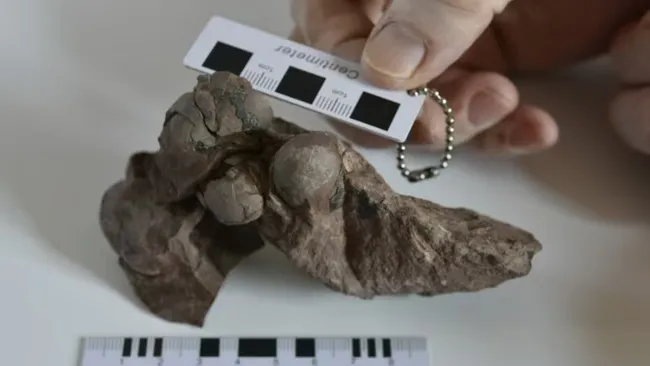Half a dozen dinosaur eggs, each around the size of a grape, were recently saved from a construction site in China. Researchers say the tiny fossilized shells are exceptionally well preserved.
Discovery of the Smallest Nonavian Dinosaur Eggs in China
Paleontologists have made an exciting discovery in China: the smallest-known nonavian dinosaur eggs have been unearthed, belonging to a previously unidentified species. These tiny eggs, each approximately the size of a grape, were found at a construction site just in time to prevent potential destruction from ongoing building work.
The Ganzhou Mini Eggs

The six minuscule eggs, dubbed the “Ganzhou mini eggs,” were recovered during a field survey at a construction site near Ganzhou in southeastern China in 2021. Chinese state media reported that the fossilized shells were irregularly arranged within a lump of rock, making it challenging to determine if they were part of a single nest. The rock is estimated to date back roughly 80 million years, placing it firmly in the Cretaceous period, which lasted from about 145 million to 66 million years ago.
A Record-Breaking Find
The smallest of these newly discovered eggs measures just 1.1 inches (2.9 centimeters) in length, shattering the previous record for the smallest nonavian dinosaur egg. That title was held by an egg from the chicken-sized dinosaur Himeoolithus murakamii, which lived around 110 million years ago and measured 1.8 inches (4.5 cm), according to Guinness World Records. In comparison, the newly discovered eggs are about half the size of a typical chicken egg.
New Species Identification: Minioolithus ganzhouensis
In a study published on October 14 in the journal Historical Biology, researchers determined that the eggs likely belong to a never-before-seen species of nonavian theropod dinosaur, a group that includes bipedal and largely predatory dinosaurs like Tyrannosaurus rex. This new species has been named Minioolithus ganzhouensis, although it remains unclear how large this dinosaur would have grown after hatching.
Exceptional Preservation
The tiny eggs are remarkably well-preserved, with detailed analysis conducted using scanning electron microscopy revealing that the internal structure of the shells has largely remained intact. This level of preservation is crucial for further studies.
Implications for Understanding Dinosaur Reproduction
Future research on these eggs could provide valuable insights into the reproductive biology of Late Cretaceous theropod dinosaurs. Fenglu Han, a paleontologist at China University of Geosciences in Wuhan and co-author of the study, highlighted the importance of these findings in understanding dinosaur reproduction during this period.
Egg Size and Species Growth
Dinosaur eggs exhibit a wide variety of shapes and sizes, and interestingly, the size of an egg does not necessarily predict the adult size of the species that laid it. For example, some ornithopods (duck-billed dinosaurs) laid eggs measuring 5.4 inches (13.7 cm), while some titanosaurs, the largest land animals ever, hatched from eggs only 5.9 inches (15 cm) long, despite growing to be four times longer than ornithopods.
Comparison with Avian Eggs
While the newly discovered dinosaur eggs are exceptionally small, they are not as tiny as those laid by some of the last remaining dinosaurs—birds. The record for the smallest known avian egg belongs to the vervain hummingbird (Mellisuga minima), whose eggs can measure as small as 0.4 inches (0.1 cm) long and weigh less than a paper clip, according to Guinness World Records.
This remarkable find sheds light on the diversity of dinosaur reproduction and continues to intrigue scientists and enthusiasts alike.
